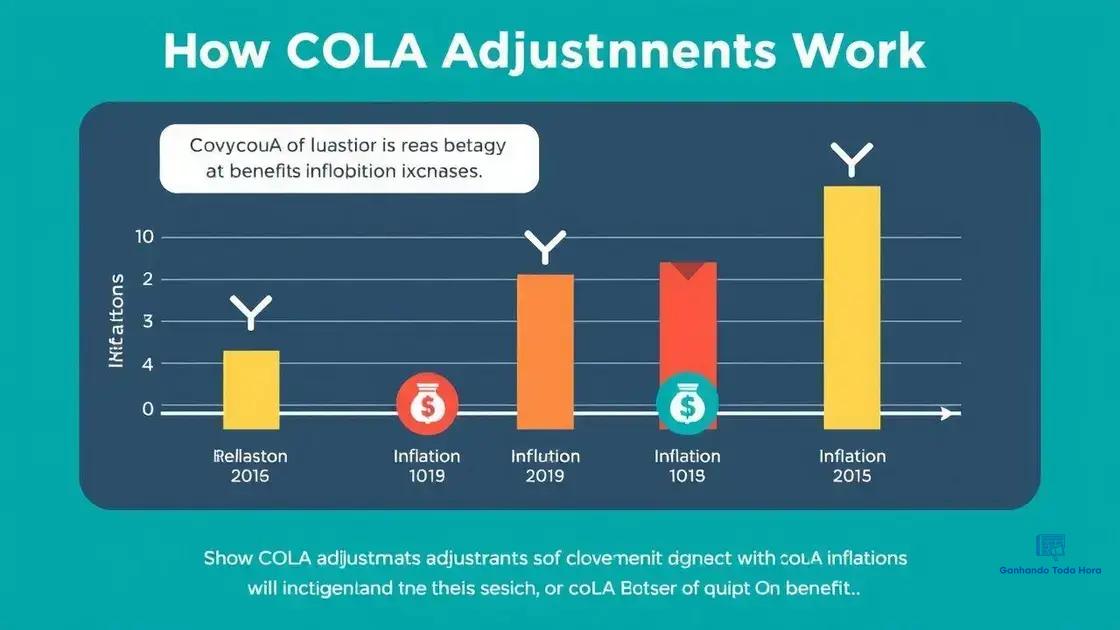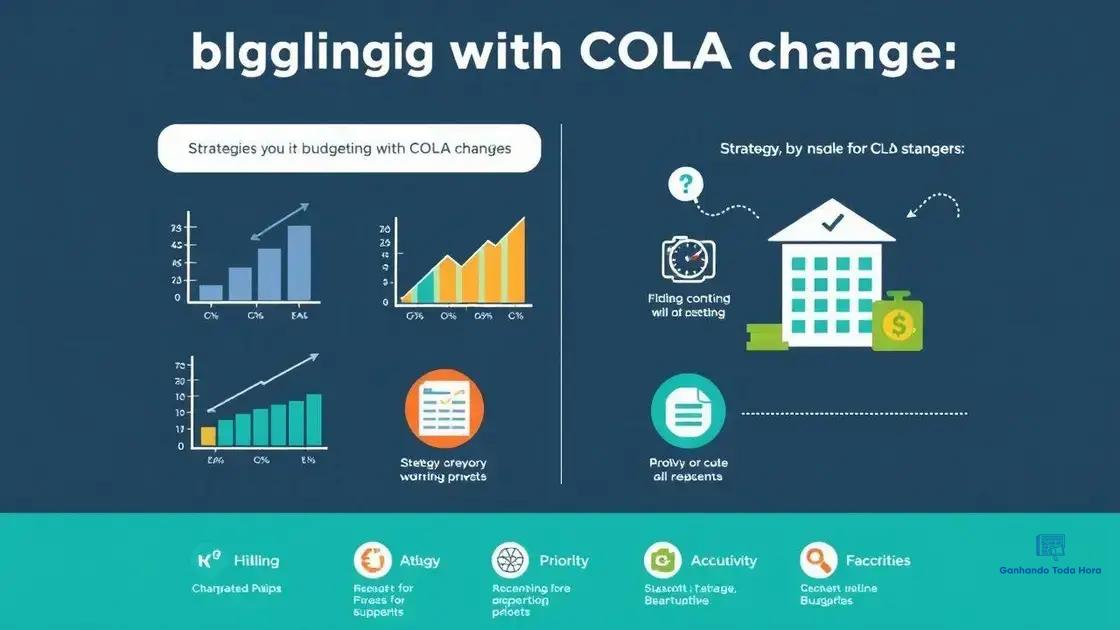2.5% COLA update: what it means for your finances
Anúncios
The 2.5% COLA update adjusts benefits to match rising costs, ensuring that individuals on fixed incomes can maintain their purchasing power amid inflation.
The 2.5% COLA update is crucial for many, especially those relying on fixed incomes. Have you thought about how this change might affect your financial decisions? Let’s explore what this means for you.
Understanding the 2.5% COLA update
The 2.5% COLA update is an essential adjustment that affects many individuals, especially retirees. It’s designed to help keep their purchasing power intact in response to inflation. Knowing how this update works can greatly influence your financial planning.
Understanding COLA
COLA stands for Cost-of-Living Adjustment. Every year, the federal government evaluates economic conditions to determine the appropriate COLA rate. This ensures that benefits keep up with rising living costs.
Why a 2.5% Increase?
This year’s 2.5% COLA update is significant. It reflects the economic conditions over the past year, including inflation rates. Factors like rising food costs and housing expenses can drive up this adjustment. Here are some reasons behind the increase:
- Higher prices on essential goods.
- Increased healthcare costs.
- Changes in the housing market.
Understanding the reason for the increase helps recipients prepare their finances wisely.
The Benefits of the COLA Update
A greater COLA means that your benefits are more likely to afford you a similar lifestyle, even as prices go up. This makes it easier for millions of Americans to manage their everyday expenses. The 2.5% COLA update can provide relief to those on fixed incomes.
It’s also crucial to remember that while COLA helps, receiving an adjustment doesn’t mean financial struggles will vanish. Effective budgeting is still important.
Staying informed about changes in the COLA ensures beneficiaries can take full advantage of their benefits. By understanding how the 2.5% COLA update impacts your benefits, you can better navigate your financial future.
How COLA adjusts your benefits

Understanding how COLA adjusts your benefits is essential for anyone relying on Social Security or other fixed income sources. Cost-of-Living Adjustments are designed to ensure that your benefits keep pace with inflation.
Mechanics of COLA Adjustments
The adjustment process begins with the Consumer Price Index (CPI). When the CPI increases, it indicates a rise in living costs. Consequently, a COLA is typically implemented to reflect these changes.
Every year, the government reviews economic conditions and determines the percentage of the increase. For instance, this year’s 2.5% COLA update directly correlates with the changes in the CPI.
Impact on Monthly Benefits
This adjustment is reflected in the monthly benefits you receive. A COLA means more money in your pocket, helping you to cover rising expenses.
- Increased benefits help manage inflation effects.
- Ensures that your purchasing power remains stable.
- Can influence budgeting and financial decisions.
Keeping up with the COLA adjustments can empower you to tailor your finances each year. It’s important to regularly review your budget as these changes happen.
Beyond the immediate financial relief, understanding how COLA adjustments work gives you confidence in your future financial planning. You can anticipate the impacts and prepare accordingly.
Impact of COLA on inflation
The relationship between COLA and inflation is crucial for understanding how your purchasing power changes over time. A Cost-of-Living Adjustment directly responds to inflation, ensuring that benefits do not fall behind when prices increase.
What is Inflation?
Inflation refers to the rate at which the general level of prices for goods and services rises. When inflation occurs, each dollar buys fewer goods and services than before. This scenario is where COLA plays an important role in protecting your finances.
With the increasing cost of living, COLA adjustments help to mitigate the effects of inflation on fixed incomes. If your benefits grow in line with inflation, you can maintain your standard of living. Conversely, if there is no adjustment, your purchasing power diminishes.
How COLA Addresses Inflation
This year, the 2.5% COLA update aims to offset the rising costs spurred by inflation, affecting everything from groceries to healthcare. When benefits are adjusted, recipients can better manage:
- Higher food prices.
- Increased housing costs.
- Rising healthcare expenses.
Essentially, COLA becomes a protective measure against the erosion of savings and earnings due to inflation. As such, it’s vital for beneficiaries to understand how this adjustment aligns with inflation rates.
Moreover, paying attention to COLA announcements can provide insights into broader economic trends. Economic studies reveal a strong correlation between COLA adjustments and inflation measurements, emphasizing its importance in personal financial planning.
Strategies for budgeting with COLA changes

Adapting your budget according to COLA changes is vital for managing your finances effectively. As costs fluctuate, it’s essential to rethink your financial strategies to match your new income levels.
Adjusting Your Budget
With the latest 2.5% COLA update, reviewing your current budget helps ensure that your spending aligns with your new financial reality. Start by taking a fresh look at your income and expenses. Make sure to incorporate the new adjustments in your plans.
Prioritizing Expenses
It’s wise to separate your expenses into categories, distinguishing between necessities and discretionary spending. Here are some categories to consider:
- Housing costs, such as rent or mortgage.
- Food and groceries.
- Healthcare expenses.
- Utility bills.
By prioritizing necessary expenses, you can allocate the increased funds from COLA adjustments effectively.
Rethinking discretionary spending is equally important. While it may be tempting to spend more freely with increased benefits, keeping a close watch on non-essential expenses can help maintain long-term financial health.
Creating a Flexible Plan
Building a flexible budget is crucial. As inflation and costs can be unpredictable, having a plan that allows adjustments will enable you to respond to unforeseen financial changes swiftly. Consider setting aside an emergency fund from your COLA increase, giving you extra security.
Staying informed and proactive will lead to better outcomes in financial management. The impacts of COLA on your budget require ongoing attention to ensure that your finances remain stable.
Future implications of COLA adjustments
Understanding the future implications of COLA adjustments is important for anyone relying on fixed incomes. As economic conditions change, so will the adjustments that determine how much your benefits increase each year.
Long-Term Financial Planning
With inflation rates fluctuating, it’s essential to consider how future COLA adjustments can impact your finances. Planning for these changes can help you sustain your lifestyle over the long term. If COLA increases align with or exceed inflation, you maintain your purchasing power.
Potential Economic Scenarios
Several economic scenarios could affect future COLA adjustments:
- Continued inflation may lead to higher COLA increases.
- Economic downturns could result in minimal or no adjustments.
- Changes in government policy might impact how COLA is calculated.
Monitoring these trends will allow you to adjust your budget and financial goals accordingly. Staying informed about economic indicators is crucial.
Impact on Retirement Planning
For retirees, knowing how COLA adjustments can evolve is essential for crafting a solid retirement plan. If future adjustments are less than expected, retirees may need to find additional income sources to maintain their standard of living.
Having a strategy in place for various COLA scenarios enables retirees to allocate resources effectively. It also encourages revisiting investments or savings plans when unexpected changes occur.
Awareness of future COLA implications can empower individuals to take charge of their financial health. By preparing for different possibilities, you can build a more resilient financial future.
In conclusion, understanding the COLA updates is essential for managing your finances, especially as costs change over time. By knowing how COLA adjusts your benefits, the impact on inflation, and their future implications, you can effectively strategize your budgeting. Staying proactive about financial planning ensures you maintain your standard of living and adapt to economic shifts. Utilizing these insights empowers you to make informed decisions that can safeguard your financial future.
FAQ – Frequently Asked Questions about COLA Updates
What is COLA?
COLA stands for Cost-of-Living Adjustment, which helps ensure that benefits keep pace with inflation and rising costs.
How does COLA affect my benefits?
COLA increases your benefits to help maintain your purchasing power during times of inflation.
What factors determine COLA increases?
COLA increases are determined by changes in the Consumer Price Index (CPI), reflecting the cost of goods and services.
How can I prepare for future COLA adjustments?
Staying informed about economic trends and adjusting your budget accordingly can help you prepare for any future COLA changes.